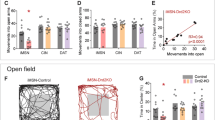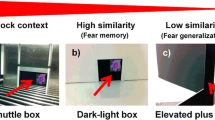Abstract
Abnormal approach-avoidance behavior has been linked to deficits in the mesolimbic dopamine (DA) system of the brain. Recently, increasing evidence has indicated that toll-like receptor 4 (TLR4), an important pattern-recognition receptor in the innate immune system, can be directly activated by substances of abuse, resulting in an increase of the extracellular DA level in the nucleus accumbens. We thus hypothesized that TLR4-dependent signaling might regulate approach-avoidance behavior. To test this hypothesis, we compared the novelty-seeking and social interaction behaviors of TLR4-deficient (TLR4 −/−) and wild-type (WT) mice in an approach-avoidance conflict situation in which the positive motivation to explore a novel object or interact with an unfamiliar mouse was counteracted by the negative motivation to hide in exposed, large spaces. We found that TLR4 −/− mice exhibited reduced novelty-seeking and social interaction in the large open spaces. In less stressful test apparatuses similar in size to the mouse cage, however, TLR4 −/− mice performed normally in both novelty-seeking and social interaction tests. The reduced exploratory behaviors under approach-avoidance conflict were not due to a high anxiety level or an enhanced fear response in the TLR4 −/− mice, as these mice showed normal anxiety and fear responses in the open field and passive avoidance tests, respectively. Importantly, the novelty-seeking behavior in the large open field induced a higher level of c-Fos activation in the nucleus accumbens shell (NAcSh) in TLR4 −/− mice than in WT mice. Partially inactivating the NAcSh via infusion of GABA receptor agonists restored the novelty-seeking behavior of TLR4 −/− mice. These data suggested that TLR4 is crucial for positive motivational behavior under approach-avoidance conflict. TLR4-dependent activation of neurons in the NAcSh may contribute to this phenomenon.





Similar content being viewed by others
References
Phaf RH, Mohr SE, Rotteveel M, Wicherts JM. Approach, avoidance, and affect: a meta-analysis of approach-avoidance tendencies in manual reaction time tasks. Front Psychol 2014, 5: 378.
Robinson TE, Berridge KC. The neural basis of drug craving: an incentive-sensitization theory of addiction. Brain Res Rev 1993, 18: 247–291.
Robinson TE, Berridge KC. The psychology and neurobiology of addiction: an incentive-sensitization view. Addiction 2000, 95 Suppl 2: S91–117.
Baker TB, Piper ME, Mccarthy DE, Majeskie MR, Fiore MC. Addiction motivation reformulated: An affective processing model of negative reinforcement. Psychol Rev 2004, 111: 33–51.
Volkow ND, Wang GJ, Fowler JS, Tomasi D, Baler R. Food and drug reward: overlapping circuits in human obesity and addiction. Curr Top Behav Neurosci 2012, 11: 1–24.
Pierce K, Courchesne E. Evidence for a cerebellar role in reduced exploration and stereotyped behavior in autism. Biol Psychiatry 2001, 49: 655–664.
Greco B, Manago F, Tucci V, Kao HT, Valtorta F, Benfenati F. Autism-related behavioral abnormalities in synapsin knockout mice. Behav Brain Res 2013, 251: 65–74.
Betz C, Mihalic D, Pinto ME, Raffa RB. Could a common biochemical mechanism underlie addictions? J Clin Pharm Ther 2000, 25: 11–20.
Karim R, Chaudhri P. Behavioral Addictions: An Overview. J Psychoactive Drugs 2012, 44: 5–17.
Marazziti D, Presta S, Baroni S, Silvestri S, Dell’osso L. Behavioral addictions: a novel challenge for psychopharmacology. CNS Spectr 2014, 19: 486–495.
Tang SC, Arumugam TV, Xu X, Cheng A, Mughal MR, Jo DG, Lathia, JD, et al. Pivotal role for neuronal Toll-like receptors in ischemic brain injury and functional deficits. Proc Natl Acad Sci USA 2007, 104: 13798–13803.
Okun E, Griffioen KJ, Mattson MP. Toll-like receptor signaling in neural plasticity and disease. Trends Neurosci 2011, 34: 269–281.
Barak B, Feldman N, Okun E. Toll-like receptors as developmental tools that regulate neurogenesis during development: an update. Front Neurosci 2014, 8: 272.
Hogg S. A review of the validity and variability of the elevated plus-maze as an animal model of anxiety. Pharmacol Biochem Behav 1996, 54: 21–30.
Moraga A, Pradillo JM, Cuartero MI, Hernández-Jiménez M, Oses M, Moro MA, et al. Toll-like receptor 4 modulates cell migration and cortical neurogenesis after focal cerebral ischemia. FASEB J 2014, 28: 4710–4718.
Painsipp E, Koefer MJ, Sinner F, Holzer P. Prolonged depression-like behavior caused by immune challenge: influence of mouse strain and social environment. PLoS One 2011, 6: e20719.
Pandey GN, Rizavi HS, Ren X, Bhaumik R, Dwivedi Y. Toll-like receptors in the depressed and suicide brain. J Psychiatr Res 2014, 53: 62–68.
Pascual, M, Baliño, P, Alfonso-Loeches, S, Aragón, CM, Guerri, C. Impact of TLR4 on behavioral and cognitive dysfunctions associated with alcohol-induced neuroinflammatory damage. Brain Behav Immun 2011, Suppl 1: S80–91
Jacobsen J, Watkins L, Hutchinson M. Discovery of a Novel Site of Opioid Action at the Innate Immune Pattern-Recognition Receptor TLR4 and its Role in Addiction. Int Rev Neurobiol 2014, 118: 129–163.
Northcutt AL, Hutchinson MR, Wang X, Baratta MV, Hiranita T, Cochran TA, et al. DAT isn’t all that: cocaine reward and reinforcement require Toll-like receptor 4 signaling. Mol Psychiatry 2015, 20: 1525–1537
Enter D, Colzato L, Roelofs K. Dopamine transporter polymorphisms affect social approach–avoidance tendencies. Genes Brain Behav 2012, 11: 671– 676.
Brooks AM, Berns GS. Aversive stimuli and loss in the mesocorticolimbic dopamine system. Trends Cogn Sci 2013, 17: 281–286.
Brodkin ES, Hagemann A, Nemetski SM, Silver LM. Social approach–avoidance behavior of inbred mouse strains towards DBA/2 mice. Brain Res 2004, 1002: 151–157.
Franklin K, and Paxinos G. The Mouse Brain in Stereotaxic Coordinates, Third Edition, San Diego: Academic Press, 2008: 45–49.
Hoffman AF, Lupica CR. Direct actions of cannabinoids on synaptic transmission in the nucleus accumbens: a comparison with opioids. J Neurophysiol 2001, 85: 72–83
Sims GP, Rowe DC, Rietdijk ST, Herbst R, Coyle AJ. HMGB1 and RAGE in inflammation and cancer. Annu Rev Immunol 2010, 28: 367–88
Akira S, Takeda K. Toll-like receptor signalling. Nat Rev Immunol 2004, 4: 499–511.
Kaul D, Habbel P, Derkow K, Kruger C, Franzoni E, Wulczyn FG, et al. Expression of Toll-like receptors in the developing brain. PLoS One 2012, 7: e37767.
Carty M, Bowie AG. Evaluating the role of Toll-like receptors in diseases of the central nervous system. Biochem Pharmacol 2011, 81: 825–837.
Stellwagen D, Beattie EC, Seo JY, Malenka RC. Differential regulation of AMPA receptor and GABA receptor trafficking by tumor necrosis factor-α. J Neurosci 2005, 25: 3219–3228.
Mandolesi G, Musella A, Gentile A, Grasselli G, Haji N, Sepman H, et al. Interleukin-1β alters glutamate transmission at purkinje cell synapses in a mouse model of multiple sclerosis. J Neurosci 2013, 33: 12105–12121.
Long-Smith CM, Collins L, Toulouse A, Sullivan AM, Nolan YM. Interleukin-1β contributes to dopaminergic neuronal death induced by lipopolysaccharide-stimulated rat glia in vitro. J Neuroimmunol 2010, 226: 20–26.
Hutchinson M, Northcutt A, Hiranita T, Wang X, Lewis S, Thomas J, et al. Opioid activation of toll-like receptor 4 contributes to drug reinforcement. J Neurosci 2012, 32: 11187–11200.
Hutchinson MR, Watkins LR. Why is neuroimmunopharmacology crucial for the future of addiction research? Neuropharmacology 2014, 76: 218–227.
Okun E, Barak B, Saada-Madar R, Rothman SM, Griffioen KJ, Roberts N, et al. Evidence for a developmental role for TLR4 in learning and memory. PloS One 2012, 7: e47522.
Meredith G. The synaptic framework for chemical signaling in nucleus accumbens. Ann NY Acad Sci 1999, 877: 140–156.
Lobo MK, Covington HE, Chaudhury D, Friedman AK, Sun H, Damez-Werno D, et al. Cell type–specific loss of BDNF signaling mimics optogenetic control of cocaine reward. Science 2010, 330: 385–390
Bock R, Shin JH, Kaplan AR, Dobi A, Markey E, Kramer PF, et al. Strengthening the accumbal indirect pathway promotes resilience to compulsive cocaine use. Nat Neurosci 2013, 16: 632–638.
Hikida T, Yawata S, Yamaguchi T, Danjo T, Sasaoka T, Wang Y, et al. Pathway-specific modulation of nucleus accumbens in reward and aversive behavior via selective transmitter receptors. Proc Natl Acad Sci USA 2013, 110: 342–347.
Surmeier DJ, Ding J, Day M, Wang Z, Shen W. D1 and D2 dopamine-receptor modulation of striatal glutamatergic signaling in striatal medium spiny neurons. Trends Neurosci 2007, 30: 228–235.
Robison AJ, Nestler EJ. Transcriptional and epigenetic mechanisms of addiction. Nat Rev Neurosci 2011, 12: 623–637.
Pothuizen HH, Jongen-Rêlo AL, Feldon J. The effects of temporary inactivation of the core and the shell subregions of the nucleus accumbens on prepulse inhibition of the acoustic startle reflex and activity in rats. Neuropsychopharmacology 2005, 30: 683–696.
Ghods-Sharifi S, Floresco SB. Differential effects on effort discounting induced by inactivations of the nucleus accumbens core or shell. Behav Neurosci 2010, 124: 179–191
Johansson K, Hansen S. Novelty seeking and harm avoidance in relation to alcohol drinking in intact rats and following axon-sparing lesions to the amygdala and ventral striatum. Alcohol 2002, 37:147–156.
Hikida T, Kimura K, Wada N, Funabiki K, Nakanishi S. Distinct roles of synaptic transmission in direct and indirect striatal pathways to reward and aversive behavior. Neuron 2010, 66: 896–907
Brog JS, Salyapongse A, Deutch AY, Zahm DS. The patterns of afferent innervation of the core and shell in the “Accumbens” part of the rat ventral striatum: Immunohistochemical detection of retrogradely transported fluoro-gold. J Comp Neurol 1993, 338: 255–278.
Reynolds SM, Zahm DS. Specificity in the projections of prefrontal and insular cortex to ventral striatopallidum and the extended amygdala. J Neurosci 2005, 25: 11757–11767.
Reynolds SM, Berridge KC. Emotional environments retune the valence of appetitive versus fearful functions in nucleus accumbens. Nat Neurosci 2008, 11: 423–425.
Ahmari SE, Spellman T, Douglass NL, Kheirbek MA, Simpson HB, Deisseroth K, et al. Repeated cortico-striatal stimulation generates persistent OCD-like behavior. Science 2013, 340: 1234–1239
Seif T, Chang S-J, Simms JA, Gibb SL, Dadgar J, Chen BT, et al. Cortical activation of accumbens hyperpolarization-active NMDARs mediates aversion-resistant alcohol intake. Nat Neurosci 2013, 16: 1094–1100.
Bardo MT, Donohew RL, Harrington NG. Psychobiology of novelty seeking and drug seeking behavior. Behav Brain Res 1996, 77: 23–43.
Belin D, Berson N, Balado E, Piazza PV, Deroche-Gamonet V. High-novelty-preference rats are predisposed to compulsive cocaine self-administration. Neuropsychopharmacology 2011, 36: 569–579.
Daffner KR, Rentz DM, Scinto LFM, Faust R, Budson AE, Holcomb PJ. Pathophysiology underlying diminished attention to novel events in patients with early AD. Neurology 2001, 56: 1377–1383.
Acknowledgments
This work was supported by the National Basic Research Development Program (973 Program) of China (2013CB530902), the National Natural Science Foundation of China (91132712, 81571125, 81221003 and 81300979), the Natural Science Foundation of Zhejiang Province, China (LR12C09001 and Q13C090002), and the Fundamental Research Funds for the Central Universities of China (2014FZA7008). Chunlu Li was partly supported by a Chinese Postdoctoral Science Foundation grant (2015M570501).
Author information
Authors and Affiliations
Corresponding authors
Additional information
Chunlu Li and Yixiu Yan have contributed equally to this work.
Rights and permissions
About this article
Cite this article
Li, C., Yan, Y., Cheng, J. et al. Toll-Like Receptor 4 Deficiency Causes Reduced Exploratory Behavior in Mice Under Approach-Avoidance Conflict. Neurosci. Bull. 32, 127–136 (2016). https://doi.org/10.1007/s12264-016-0015-z
Received:
Accepted:
Published:
Issue Date:
DOI: https://doi.org/10.1007/s12264-016-0015-z




